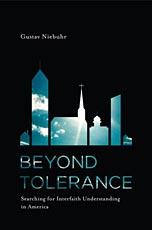In the post-9/11 world with its ongoing war on terrorism, religion is for many a major contributor to fear, distrust, and violence. But a countertrend is emerging: "the idea that some people choose to build networks that deliberately cross boundaries in an era in which religious differences are so explosive." Many leading spiritual figures have advocated peace across religious lines including Thomas Merton, Martin Buber, Abraham Joshua Heschel, Pope John Paul II, and the Dalai Lama. Today the spectrum of religious tradition and practice is wider than ever, and more Americans are meeting with those of other faiths. According to a Hartford Institute for Religion Research study, of the estimated 335,000 churches in the United States, between 20,000 and 25,000 have been involved in interreligious activities.
Gustav Niebuhr is a former religion reporter for The New York Times and presently serves as an associate professor of religion and media at Syracuse University. In this study, he profiles some contemporary pioneers of interfaith work including Bishop Swing and his United Religious Initiative, Eboo Patel's Interfaith Youth Corps, and the Catholic organized Festival of Faiths in Louisville, Kentucky. The big change is that ecumenical groups involving Protestants, Catholics, and sometimes Jews are now reaching out to include Muslims. In turn, many Islamic organizations are co-operating with other religious groups.
Niebuhr concludes by noting that although the interfaith ideal is spreading, there is no central organization holding it all together and providing vision, leadership, and resources. Interfaith contacts have mainly revolved around dialogues and talking while many who have been involved in the trenches see the need to move on to an emphasis on the spiritual practices which religions have in common. And certainly, in the future, all the world's religions need to unite to serve the poor, the persecuted, and those faltering under injustices.
